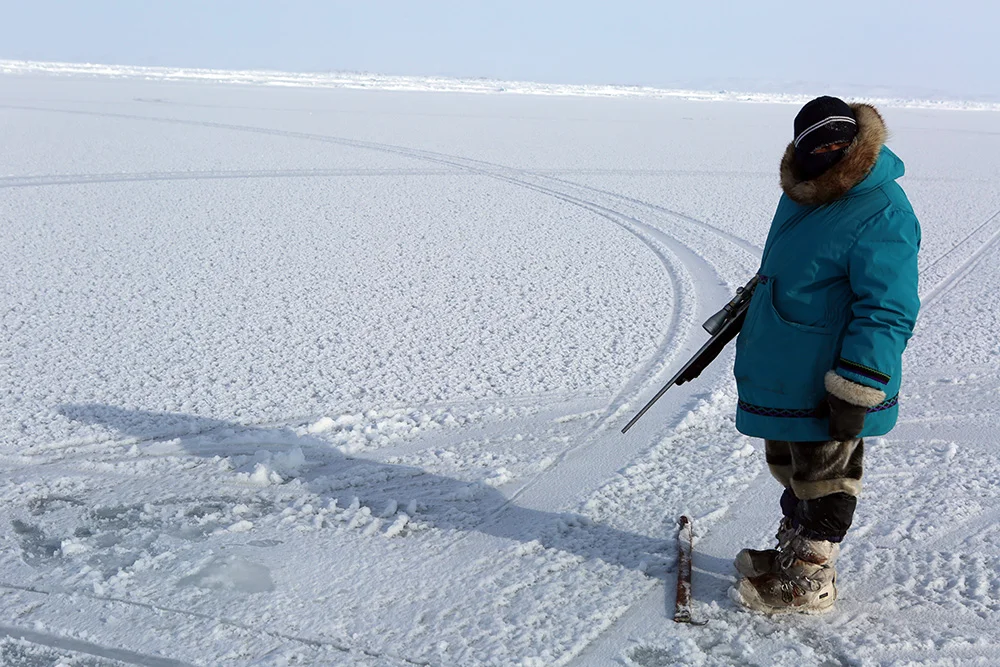ARCTIC ENVIRONMENTS, RESOURCE EXTRACTION, AND INDIGENOUS WOMEN DOCUMENTARY FILMMAKERS
Vulkan, Ann Holmgren
Tekst: Scott MacKenzie and Anna Westerstahl Stenport
The documentary has been the most important form of moving images made in the global circumpolar Arctic since the early 1900s, when all-male polar and anthropological expeditions brought cameras north to depict supposedly heroic feats of land-claiming exploration and the Indigenous populations they encountered. Many of those early documentaries, as well as later classics such as Robert Flaherty’s Nanook of the North (USA, 1922), focused on extreme environments and exoticized and infantilized Indigenous populations. These colonial and patriarchal stereotypes influenced documentary depictions of the North for generations. A number of recent documentaries by Indigenous women take radically different approaches. Filmmakers such as Alethea Arnaquq-Baril (Nunavut), Liselotte Wajstedt (Sápmi), Britt Kramvig (Sápmi), Aka Hansen (Greenland), Pipaluk Knudsen-Ostermann (Greenland), and Eva Belova (Russia) instead foreground women as politically activist spokespeople that emphasize a contemporary complexity of lived experiences in Northern environments. These filmmakers protest the ways in which outsiders’ resource extraction, pollution, and use of Indigenous lands have negatively impacted the social fabric of communities, while demonstrating that in the 21st Century, the Arctic is globally interconnected.
Angry Inuk, Alethea Arnaquq-Baril
Arnaquq-Baril’s documentary Angry Inuk (Canada, 2016), combining traditional documentary modes with animation, spans nearly a decade, starting in 2008 just before an EU vote on the seal hunt, and ends in 2015, after an Inuit-originating lawsuit against the EU has been turned down and the complete ban on any commercial trade in seal products upheld. Angry Inuk argues that for Nunavut’s coastal Indigenous communities to survive, they must be able to run an ecologically sustainable global trade of seal skins. Otherwise, they may be forced to accept mining or other disruptive extraction, detrimental to both communities and environments. The economic factor is important as the cost of living is exponentially high in the Arctic and seal skins must be used as a means of commodity exchange. Moreover, the Inuit entering the global marketplace encounter old racist notions, as if money or capital were not needed in the far North. Angry Inuk foregrounds women’s roles as spokespeople for the Inuit in cultural, political, and economic matters. Arnaquq-Baril’s voice also functions as a counterpoint to the many white animal rights activists -- a majority of them women -- who self-silence and will not defend their views publicly in the face of a critically engaged Indigenous woman.
Kiruna Space Road, Liselotte Wajstedt
Kiruna Space Road, Liselotte Wajstedt
Wajstedt’s Kiruna Space Road (Sweden, 2013) is an experimental documentary addressing the destructive effects of large-scale mining on Indigenous lands. Documenting Wajstedt’s return from Stockholm to her home-town Giron [Kiruna], the film presents a self-reflexive, first person account of the forced move of the city center three km eastward, as the LKAB mining operation expands relentlessly underneath it. The interplay between activities underground, in the bowels of a beautiful valley that is also marked by a century of iron ore mining operations, and the tracing of memories seemingly lost in the dark recesses of the filmmaker’s mind, provide a compelling pair of conceptual vantage points: both the material and the psychological are shown to be split and bifurcated.
Thematic and aesthetic hybridization is key to Wajstedt’s depiction of environments and Sápmi. Kiruna Space-Road is, in part, an ‘animated documentary’, often considered a newly developed hybrid, but which can be traced back to the beginnings of cinema: the two forms have a long, entangled history. Wajstedt’s use of animation -- cell animation, superimposition, computer animation, stop-motion and claymation -- functions in a number of interweaving ways. Superimposed images of flying birds denote the Sámi history of the area and the naming of the mountain ranges. The aesthetic use of superimposition serves to put past and present in the same frame. Animation allows for a process of defamiliarization of the realist aesthetic so often dominant in Arctic documentary cinema and resource extraction films. Wajstedt’s film is as much a work of memory and memorialization -- both of Giron and of her childhood -- as it is a straight documentary about the events surrounding the town perched atop the mine.
Ann Holmgren’s short Volcano (Sweden, 2017) parallels Kiruna Space-Road. The meditative monochromatic docudrama is described by the filmmaker as an “existential Road movie.” Volcano depicts loss of hope and a search for meaning. Edith, a Kiruna teenager, wanders through the town asking questions about life’s meanings. In conversations with residents -- based on interviews -- and her observations, she absorbs their fears and hopes for the future, with the cityscape behind her as an allegorical statement about the destruction of the city they call home. While the ever-present mine is addressed, the upcoming migration never is, though parts of the city look already abandoned. Her journey is one of both discovery and loss --a search for identity -- and like Wajstedt’s film, tries to seam together cracks in the surface of both Edith and her community. Volcano ends with Edith seemingly walking out of the city.
These three films, all in this year’s AMIFF program, offer insight into a quickly growing body of works at the intersections of Arctic activist documentary, first person experimental narrative, and environmental awareness made by Arctic women Indigenous filmmakers. These works challenge patriarchal narratives of the Arctic, and in so doing, create new forms of feminist filmmaking that decenter the figure of the White male in the Arctic, allowing new spaces and voices to emerge. These works represent the profound heterogeneity that has always been central to any conceptualization of the Arctic, which nonetheless has more often than not been projected as an image of homogeneity, leaving women and Indigenous peoples out of the representational equation.
Vulkan, Ann Holmgren






